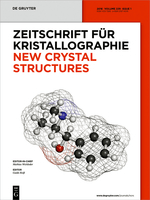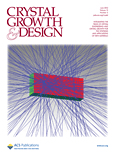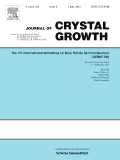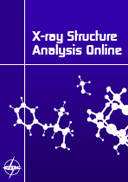
ZEITSCHRIFT FUR KRISTALLOGRAPHIE-NEW CRYSTAL STRUCTURES
Scope & Guideline
Connecting Researchers to Crystal Discoveries
Introduction
Highly-cited Topics
- Metal-Organic Frameworks (MOFs) and Coordination Compounds:
Research on metal-organic frameworks and coordination compounds is gaining momentum due to their applications in catalysis, gas storage, and drug delivery. The intricate structures and functionalities of these materials make them a hot topic in materials science and chemistry. - Crystallography of Organic Compounds:
The detailed study of organic compound crystal structures is crucial for understanding molecular interactions and properties. This area attracts citations due to its foundational role in drug design and materials science. - Structural Characterization of Bioactive Molecules:
The crystallography of bioactive molecules, such as those with pharmaceutical relevance, is a rapidly growing field. Papers in this area often receive high citations as they provide essential insights for drug development and medicinal chemistry. - Advanced Synthesis Techniques in Crystallography:
Innovations in synthesis methods for new crystalline materials are of high interest. Research that introduces novel synthesis techniques or compounds often garners citations, as it opens pathways for further exploration in materials science. - Computational Crystallography:
The integration of computational methods in crystallography enhances the understanding of crystal structures and properties. This interdisciplinary approach attracts citations from both theoretical and applied research communities. - Nanostructured Materials:
The study of nanostructured materials and their crystallography is pivotal for developing next-generation materials with unique properties. This area is increasingly relevant in nanotechnology and materials engineering. - Hydrogen Bonding and Supramolecular Chemistry:
Research focusing on hydrogen bonding interactions and supramolecular assemblies is significant due to its implications in material design and biological systems. This theme is frequently cited for its broad applicability. - Solid-State Chemistry and Phase Transitions:
The exploration of solid-state chemical reactions and phase transitions presents opportunities for novel material development. Papers in this area often attract citations due to their relevance in both theoretical and practical applications.
Similar Journals

Crystals
Exploring the Boundaries of Crystalline InnovationCrystals is a premier open-access journal, published by MDPI since 2011, that focuses on the multidisciplinary fields of chemical engineering, condensed matter physics, inorganic chemistry, and materials science. With its E-ISSN 2073-4352, the journal is headquartered in Switzerland, and actively contributes to the global scientific community by facilitating the dissemination of high-quality research. Ranking in the Q2 quartile across multiple categories, including Chemical Engineering (miscellaneous) and Materials Science (miscellaneous) for 2023, Crystals provides a platform for innovative studies that span from fundamental research to practical applications. The journal's commitment to open access ensures that groundbreaking findings are readily available to researchers, professionals, and students alike, fostering an environment of collaboration and knowledge sharing that is essential in advancing the scientific understanding of crystalline materials.

Liquid Crystals and their Application
Transforming Research into Practical Solutions with Liquid CrystalsLiquid Crystals and Their Application, published by Ivanovo State University, is a pivotal journal dedicated to the exploration and dissemination of research in the field of liquid crystal science and its diverse applications. With an ISSN of 1991-3966, this journal aims to bridge the gap between fundamental studies and practical implementations, thereby contributing significantly to interdisciplinary fields such as biomaterials and materials science. Although the journal currently holds a Q4 ranking across various categories such as Biomaterials and Materials Chemistry for 2023, it is positioned to enhance its impact through high-quality peer-reviewed articles that reflect advancements in liquid crystal technology. With a geographic focus on the Russian Federation, this journal encapsulates the innovative research environment in the region while catering to a global audience of researchers, professionals, and students interested in the latest breakthroughs. While the journal is not open access, it maintains a commitment to academic integrity and high standards, inviting contributions that will elucidate the evolving landscape of liquid crystals from 2016 through 2024 and beyond.

CRYSTAL GROWTH & DESIGN
Exploring the Frontiers of Crystal ScienceCRYSTAL GROWTH & DESIGN, published by the American Chemical Society, is a premier journal dedicated to the interdisciplinary study of materials science, condensed matter physics, and miscellaneous chemistry. With an ISSN of 1528-7483 and E-ISSN of 1528-7505, this journal provides a vital platform for the dissemination of innovative research findings from 2001 through 2024, reflecting the dynamic advancements in crystal growth and design methodologies. It is recognized for its impact in the field, earning a distinguished placement in the Q2 quartile across categories of Chemistry, Condensed Matter Physics, and Materials Science for 2023. Researchers engaging with CRYSTAL GROWTH & DESIGN will find a wealth of peer-reviewed articles encompassing cutting-edge experimental techniques, theoretical frameworks, and application-oriented studies. Although not an open-access journal, it remains a critical resource for academics, professionals, and students aiming to enhance their understanding of crystal growth processes and material functionality, with Scopus rankings reflecting its reputable authority within the scientific community.

Crystallography Reviews
Exploring Multidisciplinary Insights in CrystallographyCrystallography Reviews is a premier academic journal published by Taylor & Francis Ltd, dedicated to advancing the field of crystallography and its applications across various scientific domains. With an ISSN of 0889-311X and an E-ISSN of 1476-3508, this journal has established itself as a vital resource for researchers and practitioners since its inception. It encompasses a broad scope, including insights into biochemistry, general chemistry, condensed matter physics, materials science, and structural biology, reflecting a multidisciplinary approach that is essential in today’s research environment. As indicated by its 2023 quartile rankings, it holds a distinguished position in the Q1 category for Condensed Matter Physics and Q2 in several other significant fields. Notably, it ranks #31 in the Scopus category for Structural Biology, underscoring its influence and relevance. Although it does not offer Open Access options, the journal maintains a strong commitment to quality and rigor in its publication process. For scholars and students striving for a competitive edge in crystallographic research, Crystallography Reviews serves as an indispensable tool for disseminating pivotal findings and fostering academic dialogue.

Zeitschrift fur Assyriologie und Vorderasiatische Archaologie
Fostering Dialogue on the Archaeological FrontiersZeitschrift für Assyriologie und Vorderasiatische Archäologie, published by WALTER DE GRUYTER GMBH, is a distinguished journal in the field of archaeology, focusing on the rich histories of the ancient Near East and Assyrian studies. Established in 1886, this journal has a venerable tradition of contributing to scholarly discourse, continuously curating impactful research that positions it within the Q2 quartile in the domains of Archaeology and Arts and Humanities as of 2023. With an impressive ranking of #101 out of 413 in Arts and Humanities and #98 out of 354 in Social Sciences within Scopus, the journal serves as a vital resource for researchers, professionals, and students alike. Although it operates under a subscription model, the journal's extensive coverage—from its inception to the present day—ensures a comprehensive exploration of archaeological methodologies, discoveries, and theoretical frameworks. The journal's aim is to advance the understanding of the ancient civilizations of the Near East and to foster scholarly communication across international platforms, making it an essential venue for contemporary archaeological research.

JOURNAL OF CRYSTAL GROWTH
Unveiling the Secrets of Crystal FormationJOURNAL OF CRYSTAL GROWTH, published by Elsevier, stands as a vital platform in the realm of condensed matter physics, inorganic chemistry, and materials chemistry. With its inception dating back to 1967 and a promising convergence continuing through 2024, this journal encompasses the latest research and advancements in crystal growth phenomena. Although it does not currently offer open access options, its rigorous peer-review process ensures high-quality scholarly contributions that are essential for researchers, professionals, and students alike. The journal's solid standing is reflected in its Scopus rankings, with placements in the third and second quartiles across relevant fields and notable percentiles. Operating from the heart of the Netherlands, JOURNAL OF CRYSTAL GROWTH not only fosters academic dialogue but also enhances the understanding of crystallization processes crucial for materials engineering and applied sciences, making it an indispensable resource for anyone dedicated to exploring the intricacies of crystal growth.

MRS BULLETIN
Connecting Researchers with Pioneering Discoveries.MRS BULLETIN is a distinguished academic journal published by Springer Heidelberg, focusing on groundbreaking research in the fields of condensed matter physics, materials science, and theoretical chemistry. With an impressive impact factor and categorizations in the top quartile (Q1) for 2023, it ranks among the leading journals in its field, demonstrating its critical role in advancing scientific knowledge and innovation. Operating from Heidelberg, Germany, this journal serves as an essential platform for the dissemination of high-quality research, synthesizing pivotal findings and discussions that bridge academia and industry. Researchers, professionals, and students will find invaluable insights within its pages, showcasing developments that are vital for fostering innovation in materials and physical sciences. Although it is not an open access journal, its rigorous peer-review process ensures the highest standards of scholarly communication, securing its reputation as a premier resource for current trends and breakthroughs.

CRYSTENGCOMM
Driving excellence in crystallization and materials science research.CRYSTENGCOMM is a distinguished journal published by the Royal Society of Chemistry, dedicated to advancing the field of crystallization and crystal engineering. With its impact factor consistently among the top tier in its category, CRYSTENGCOMM serves as an essential platform for researchers, professionals, and students in Chemistry, Condensed Matter Physics, and Materials Science. The journal has successfully maintained its relevance and influence since its inception, showcasing pioneering research from 1999 to 2024, with a commendable Q2 ranking in the latest evaluations. This accessibility to crucial developments in crystallization facilitates knowledge transfer across disciplines and enhances collaboration within the scientific community. Although it operates under a subscription model, the journal remains committed to disseminating cutting-edge research and fostering innovation in the field. For more information or to submit your research, please visit the Royal Society of Chemistry's website.

X-Ray Structure Analysis Online
Advancing the Frontiers of X-Ray AnalysisX-Ray Structure Analysis Online is a pivotal academic journal dedicated to the field of analytical and materials chemistry, published by the Japan Society for Analytical Chemistry. Established in 2009, this journal serves as a vital platform for researchers and professionals dedicated to advancing the understanding of X-ray structural analysis techniques and their applications. With ISSN 1883-3578, it operates under rigorous peer-review standards, promoting high-quality research contributions. While the journal is currently categorized in the Q4 quartile for both Analytical Chemistry and Materials Chemistry, its focus on cultivating a deeper understanding of material properties through X-ray analysis remains crucial for ongoing developments in these fields. By providing an accessible outlet for innovative studies, X-Ray Structure Analysis Online supports the academic community in overcoming the challenges of a rapidly evolving scientific landscape. It is particularly valuable for those engaged in material and analytical research, offering insights that contribute to both theoretical foundations and practical applications.

Journal of the Korean Crystal Growth and Crystal Technology
Driving Progress in Material Science and EngineeringJournal of the Korean Crystal Growth and Crystal Technology, published by the Korean Association for Crystal Growth, Inc, serves as a significant platform for the dissemination of research related to crystal growth and technology, emphasizing advancements in the field within the context of Korean and global scientific communities. With its ISSN 1225-1429 and E-ISSN 2234-5078, this journal invites contributions that explore the theoretical and practical aspects of crystal growth, including material science, physics, and engineering applications. Although specific metrics such as HIndex or Scopus ranks are currently unpublished, the journal is poised to impact the field significantly, appealing to researchers, professionals, and students seeking to expand their knowledge and expertise. By fostering collaboration and sharing innovative findings, the Journal of the Korean Crystal Growth and Crystal Technology is a valuable resource for those aiming to contribute to this evolving discipline.